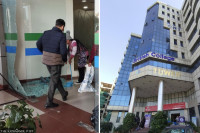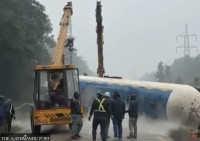National
Talk aims bringing Butwal yarn factory out of mothballs
Once Nepal’s largest spinning mill, it shut down more than a decade ago after being crippled by mismanagement.
Ghanashyam Gautam
The federal and provincial governments have revived talk of bringing Butwal Dhago Karkhana out of mothballs, but observers are sceptical as successive administrations have been saying so for more than a decade.
Once Nepal’s largest spinning mill, Butwal Dhago Karkhana shut down amid a flurry of closures of varied state-owned enterprises crippled by mismanagement and political interference.
Krishna Dhwaj Khadka, minister for economic affairs and cooperatives of Lumbini Province, said discussions were underway to reopen the iconic factory located in south central Nepal.
“It has not been decided whether to give it to the private sector or operate it through a public-private-partnership model,” he said. "Discussions are going on with the federal government and the private sector."
Khadka claimed that a decision would be reached only after extensive deliberations. He said that if the government green-lights the plan, the federal government would prepare a procedure to operate the sick industry by bringing the private sector on board.
Butwal Dhago Karkhana was established in 1983 with the objective of exporting yarn and thread to the international market.
The mill started production in 1991; but within a decade, it had gone belly up. Unions and employees attached to various political parties ran it into the ground with their endless strikes and interference.
After Nepal suffered a severe power shortage resulting in hours of rolling blackouts nationwide, the company pulled down its shutters for good.
The buildings and equipment costing millions of rupees are in a dilapidated state. The machines have developed rust.
The government established the factory with a plan to cultivate cotton in Nepalgunj, produce thread in Butwal and manufacture cloth at Hetauda Textile Mill.
Soon after opening, the company was plagued by political interference. Political appointments, corruption and mismanagement became the order of the day.
The factory's losses started piling up, and it sank neck-deep in debt. It could no longer pay its employees with the revenues from producing and selling its goods. The company eventually fell apart.
In 2003, the government leased the factory to Salt Trading Corporation, another state-owned company. But it too pulled out after a year.
The factory’s management was then taken over by the Reliance Group, a private conglomerate. It ran the factory till mid-March 2008.
Unable to control ballooning debts, the government decided to give compulsory retirement to all its workers in mid-September 2009. It has retained four people to look after the property.
The factory contains six large buildings on 143 ropanis in the Butwal Industrial Zone. The buildings with a floor area of 23,000 square metres are now covered in cobwebs.
During the rainy season, the machines are submerged in water because of leaks in the roof. Around 56 big machines used to produce yarn have rusted.

A year ago, Shankar Pokharel, then chief minister of Lumbini, had decided that the provincial government would run the factory again.
Next, Leela Giri, the minister for industry, tourism, forest and environment, pledged to revive the factory. But nothing happened.
Chief Minister Kul Prasad KC has also announced that the government would resurrect the factory. But there was nothing in the provincial budget to carry out the promise.
The policies and programmes of the federal government for this fiscal year announced by Finance Minister Janardan Sharma too have mentioned that the necessary policies would be formulated to operate Butwal Dhago Karkhana. But there was no budget allocation.
Most of the industry ministers of the federal government have visited the factory.
A succession of industry ministers, namely Anil Jha, Karna Bahadur Thapa, Mahesh Basnet, Som Prasad Pandey and Nabindra Raj Joshi, have inspected the mill. But the outcome has been zero.
A team led by Baburam Gautam, joint secretary of the Industry Ministry, completed a field study recently.
Dolraj Sharma, chief of Butwal Dhago Karkhana, said that the factory was not operable in its current situation. “It needs a complete makeover with modern technology.”
The factory had more than 700 employees in its heyday. When it closed down, it had laid off 450 permanent employees.
Baburam Bohra, former president of the Rupandehi Industry Association, said that "false assurances" had been coming from the government all the time. “One of the country's big factories and its machines have turned into wreckage.”
In 2013, the Industrial Board submitted a report to the government suggesting that the mill could be handed over to the private sector. But that suggestion too was not implemented.
Butwal Dhago Karkhana was established under a public-private partnership model. The factory had investments from the government, Khetan Group, Salt Trading, Birgunj Sugar Mill, Himal Cement, Janakpur Cigarette Factory, Nepal Industrial Development Corporation and the public.
The government holds 59.75 percent of the stock, corporations have 18.5 percent, Khetan Group 13.4 percent, Salt Trading Corporation 8.3 percent and the general public the remaining shares.
At the time of establishment, the factory had an authorised capital of Rs600 million, issued capital of Rs450 million and paid-up capital of Rs370 million. Of the total investment, Rs30 million was public capital.
Ujjwal Kasaju, president of the Butwal Chamber of Commerce and Industry, said that it would not be possible to operate the factory under the old modality.
"The public share has not been finalised, the old employees may go on strike again," Kasaju said. "There are no details of the factory's shareholders either."
Kasaju suggested that instead of reviving the yarn factory, a new textile mill would be appropriate because of the current market demand.




 8.12°C Kathmandu
8.12°C Kathmandu













%20(1).jpg&w=300&height=200)

